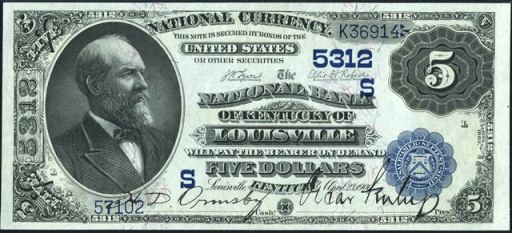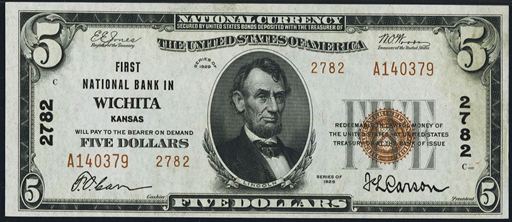The First National Bank Salamanca
The First National Bank Salamanca in New York printed $1,755,970 dollars worth of national currency. Over $1,000,000 face value is a lot of money. However, some types and denominations of currency from this bank could still be rare. This national bank opened in 1880 and stopped printing money in 1935, which equals a 56 year printing period. That is considering a long operation period for a national bank. During its life, The First National Bank Salamanca issued 9 different types and denominations of national currency. We have examples of the types listed below. Your bank note should look similar. Just the bank name will be different. For the record, The First National Bank Salamanca was located in Cattaraugus County. It was assigned charter number 2472.
We buy all national currency. Please call or email us for a quote. Sales@AntiqueMoney.com
The First National Bank Salamanca in New York issued 16,153 sheets of $5 series of 1875 national bank notes. That is a high issue number for a national bank. You are likely not dealing with a rare bank note. However, the exact value is still based on condition and a number of other factors. You might be surprised at the value. Series of 1875 $5 bills are some of the most commonly encountered bank notes from the first charter series. Only the original series $1 bill is more available. Some banks exclusively issued five dollar bills. So if you want an example from one of those banks then you don’t have many options. These notes have a rounded red seal and red serial numbers. They also all have a red charter number.
Series of 1875 $5 National Bank Note
The First National Bank Salamanca printed 4,000 sheets of $10 1882 brown back national bank notes. That it is not an exceptionally low number of sheets. However, you have to remember that we are talking about bank notes printed before 1902. Even a large print number could have a very low survival rate. There were three $10 bills printed on a single sheet of 1882 brown backs. The design of the bill is similar to all earlier ten dollar national bank notes. The nickname comes from the fact that these bills have a brown seal and brown overprint. Despite saying series of 1882, these were actually printed by some banks up until 1908. The date you see in cursive relates to when the bank first started issuing brown back notes.
Series of 1882 $10 Brown Back
The First National Bank Salamanca also printed 4,000 sheets of $20 1882 brown back national bank notes. As you can see, the sheet output is the same for $20 brown backs as it is for $10 brown backs. There was only one $20 brown back printed on a sheet. So the sheet output also equals the total note output. One neat thing about all brown backs is that they each have a different back design based on which state issued them. The back left hand side of the note shows the state seal of which ever state the national bank was located in. Generally speaking, 1882 $20 brown backs are pretty difficult to locate. They typically were printed in small numbers and they don’t have a great survival rate.
Series of 1882 $20 Brown Back
The First National Bank Salamanca also printed 6,375 sheets of $5 1882 blue seal national bank notes. That is a pretty standard sheet output number for these issues. Most of the value is going to be in the condition. 1882 $5 blue seal bank notes were issued by some national banks in The United States. While these are a somewhat rarer issue, they just aren’t especially popular with collectors. With exception of some minor differences, they look exactly like the earlier brown back series. Most collectors would prefer the brown back notes. With that said, some 1882 blue seals can still be worth thousands of dollars. So don’t just assume that what you have is automatically common.
1882 Blue Seal $5 National Bank Note
The First National Bank Salamanca also printed 3,768 sheets of $10 1882 blue seal national bank notes. That is a pretty standard sheet output number for these issues. Most of the value is going to be in the condition. All of these notes say series of 1882 but they were actually printed between 1908 and 1921. So they aren’t quite as old as the dates might suggest. There is also a date on these notes that is between 1888 and 1901. That date is written in cursive text and it represents when the bank was chartered or re-chartered. Some of the so called 1882 value back notes have a chance to be really rare. Most of the earlier notes that say 1882-1908 on the back are likely going to be relatively common. The designs are exactly the same on the front. Each has a blue seal and charter number.
1882 Blue Seal $10 National Bank Note
The First National Bank Salamanca also printed 3,768 sheets of $20 1882 blue seal national bank notes. That is the same number of sheets as the ten dollar denomination. You don’t have to multiply by three to get the exact number of notes issued though. There was only one twenty dollar bill per sheet. As with any national bank note, the exact value is still based on the condition, serial number, and bank of issue.
1882 Blue Seal $20 National Bank Note
The First National Bank Salamanca also printed 21,041 sheets of $5 1902 blue seal national bank notes. Once a bank prints more than 10,000 sheets of blue seals it becomes very difficult for those notes to be rare. Ben Harrison is on the front of all 1902 $5 blue seal bank notes. This happens to be the smallest denomination issued for the 1902 series. Each note is complete with a blue seal and blue charter number. Despite saying series of 1902, these were actually issued by national banks between 1908 and 1928. There are two different types of blue seals. The first type is called a date back and it has “1902-1908” written on the back of the bill. The other type is called a plain back; it does not have the date stamps on the back of the bill. The values for these notes range widely based on condition and the bank of issue.
1902 $5 Blue Seal National Bank Note
The First National Bank Salamanca also printed 12,304 sheets of Type1 1929 $5 national bank notes. Sadly, based on a number that high, there is basically no chance for these notes to be especially rare. Every 1929 $5 bill has a portrait of Abraham Lincoln on it. This is also the lowest denomination of small size national currency that any bank issued. All serial numbers end with the letter A and start with a letter between A and F. Remember that you can take the total number of sheets printed and multiply it by six get to the actual number of bank notes printed for this denomination. All small size national bank notes were printed on sheets of six.
Series of 1929 Type1 $5 National Bank Note
The First National Bank Salamanca also printed 25,414 individual notes from the type2 1929 $5 national bank note series. That is a high printing total. Don’t expect much rarity here, but condition factors can always make common items more valuable. This was an easy and popular denomination for national banks. Five dollars could buy a lot of different things back in 1929 and the early 1930s. 1929 type2 five dollar bank notes are available in quantities today. However, some notes can be extremely rare. The exact value all depends on the bank of issue and condition. Contact us and we would be happy to give a free appraisal.
Series of 1929 Type2 $5 National Bank Note



